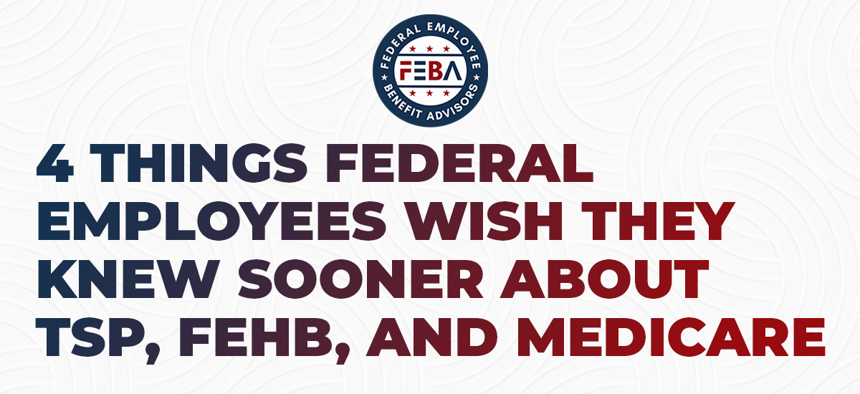sponsor content What's this?

4 Things Federal Employees Wish They Knew Sooner About TSP, FEHB, and Medicare
Presented by
FEBA

One of the biggest advantages of a federal career is access to powerful retirement benefits. But many employees don’t realize the hidden strategies within the Thrift Savings Plan (TSP), Federal Employees Health Benefits (FEHB), and Medicare until it’s too late to maximize them. Here are the things many retirees say they wish they had known earlier—and what you can do now to prepare.
1. TSP Isn’t Just a Savings Account—It’s a Lifetime Income Tool
Too many employees treat the TSP as a simple savings account, only to discover its true potential at retirement.
- Contribution Timing Matters: Increasing contributions in your final 10 years of service can significantly boost your account due to compounding. Waiting until retirement to “catch up” often leaves people short.
- Roth vs. Traditional: Many regret not balancing Traditional and Roth TSP contributions. Roth withdrawals in retirement are tax-free, which can save thousands when combined with Social Security and pension income.
- In-Service Transfer at Age 59½ – Once you reach age 59½, the in-service transfer rule allows you to move a portion of your TSP savings into an IRA or other retirement account without penalty. This gives you the ability to diversify beyond the limited TSP fund menu—especially adding tools that can provide guaranteed income, tax planning advantages, and risk management—while still keeping the low-cost C Fund exposure inside your TSP. By doing this, you set yourself up with a more balanced strategy to transition smoothly into the income phase of retirement.
Hidden Secret: The TSP isn’t just for accumulation—it can be carefully structured to provide stable income for decades.
2. FEHB Offers Flexibility Most People Overlook
FEHB is often thought of as just “health insurance you keep in retirement.” But there’s more to it.
- Lifetime Coverage: Unlike private-sector retirees who scramble for affordable coverage, eligible Feds can carry FEHB for life—if they meet the 5-year rule. Missing this requirement is one of the most common regrets.
- The Suspend Option: Few realize you can suspend FEHB if you enroll in the right Medicare plan and later return to FEHB if needed. This flexibility allows you to test cost-saving options without losing your federal safety net.
- Family Coverage Decisions: Retirees sometimes regret not switching to self-plus-one earlier, which could have saved them thousands over the years. Our advice is to weigh your options before you need them.
3. Medicare Isn’t One-Size-Fits-All
When turning 65, Medicare choices can feel overwhelming—and many retirees either pay more than they need to or miss out on savings.
- Part A Is a No-Brainer: Since it’s premium-free for most, enrolling in Part A almost always makes sense.
- Part B Requires Strategy: Some regret not taking Part B when first eligible, facing penalties later. Others regret enrolling without weighing whether FEHB alone was enough. The “right answer” depends on your health and finances.
- Coordination with FEHB: Medicare often becomes primary, with FEHB as secondary. This can cut out-of-pocket costs dramatically—if you understand how to coordinate them.
4. Timing and Coordination Create the Biggest Wins
The real secret isn’t in any one benefit—it’s in how they work together.
- TSP withdrawals combined with Social Security timing can reduce taxes and stretch savings.
- FEHB plus Medicare creates one of the strongest retiree health safety nets available.
- Smart decisions in your 50s and early 60s often unlock the most value, while waiting too long can lead to expensive mistakes.
Armor Up Your Retirement Plan
The truth is, there are hidden layers to your TSP, FEHB, and Medicare that most federal employees don’t uncover until after retirement—sometimes when it’s too late to take advantage. By learning the secrets now, you can position yourself for lower costs, more income, and stronger protection throughout your retirement years.
Next Steps for Federal Employees
Join Our Free Webinars
Learn Everything You Need to Know About Your Federal Employee Benefits
At FEBA, we offer online webinar training, in-person seminars, and onsite union/association workshops to deliver facts and details about your six main federal employee benefits. These entertaining, information-packed sessions will help you fully understand
- FERS and CSRS Pension Calculations
- Federal Employee Health Benefit (FEHB)
- Survivor’s Benefit Annuity Deduction (SBAD)
- Federal Employee’s Group Life Insurance (FEGLI)
- Social Security
- Thrift Savings Plan (TSP)
You can find our schedule of upcoming federal benefit training below.
This content is made possible by our sponsor FEBA; it is not written by and does not necessarily reflect the views of GovExec’s editorial staff.
NEXT STORY: Optimizing IT for Mission Attainment






